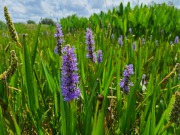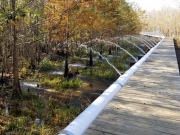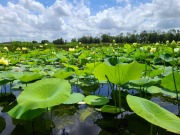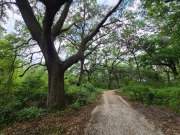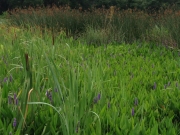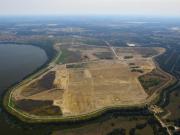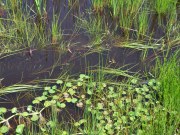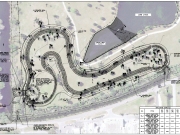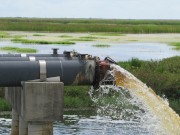Featured Treatment Wetland Projects
WSI has conducted water quality sampling at the Lake City Treatment Wetland since normal operations began in February of 2017 for the SRWMD (2017-18) and the City of Lake City (2018-present). This sampling has focused on nutrients and field parameters which have been collected at each of the cell-to-cell flow structures to evaluate wetland performance. Additionally, WSI installed and has maintained water level recorders at ten locations since project operations began to track water levels in each cell. This data collection has supported development of nutrient treatment performance for nitrogen and phosphorus. WSI also developed and has maintained a cell-by-cell and site-wide water balance to track inputs from inflow and rainfall, and losses to evapotranspiration and infiltration. Field parameter collection (dissolved oxygen, specific conductance, and pH) has captured the maturation of the plant community and shift from algae and floating aquatic plants to emergent plant communities. This performance data has also provided information that can describe the project’s performance and success to the public, organizations, and regulators. More recently, sampling has been expanded to include primary and secondary water quality parameters to support permitting for modifications at the wetland to increase recharge.
7 Photos
Since 2000, WSI has conducted water quality and biological monitoring for the BJWSA Great Swamp Effluent Management System (GSEMS), a large-scale, natural, forested wetland treatment system (480-ac). WSI staff developed and implemented the monitoring program that includes water quality sampling; stream discharge measurements; surface water levels; quantitative herbaceous and canopy vegetation measurements; fish and benthic macroinvertebrate sampling; and qualitative sampling for herpetofauna, birds, and other wildlife. The monitoring program was developed and implemented to assess compliance with South Carolina's biological criteria related to effluent discharges to natural wetlands. WSI also prepares annual monitoring reports for submittal to the South Carolina Department of Health and Environmental Control. WSI has led planting of additional bare-root seedlings for the past decade to improve the cover of hydrologically-adapted tree species. This project was expanded to increase the discharge capacity at an adjacent parcel (+580-ac). WSI led baseline monitoring efforts and assisted in permitting for this project site and the design layout. This project has since been constructed and WSI has been providing ecological monitoring to document project performance and satisfy permitting requirements.
8 Photos
WSI worked on the design of the Sweetwater Wetlands Park in Gainesville for Gainesville Regional Utilities (GRU). WSI assisted GRU, the City of Gainesville Public Works Department, and managers from Paynes Prairie Preserve State Park to improve water quality and meet a nitrogen TMDL in Sweetwater Branch, an urban stream that discharges stormwater and highly treated reclaimed wastewater to Paynes Prairie and Alachua Sink. To improve water quality and hydrologic conditions on Paynes Prairie, WSI prepared the conceptual plan and process design and modeling for a 125-acre enhancement wetland to capture and treat flows from Sweetwater Branch that also re-establishes sheetflow of polished water to the northern edge of Paynes Prairie. The tasks performed by WSI included development of recommended allowable nutrient levels for discharge; conceptual layout for a multi-compartment treatment wetland that will provide operational flexibility and facilitate access for public recreational activities; calculation of existing nutrient and pollutant loads delivered to Paynes Prairie from the Sweetwater Branch watershed; calculation of maximum flows that could be diverted from Sweetwater Branch to the enhancement wetland that would maintain compliance with the proposed downstream nutrient levels; estimation of nutrient assimilation that will naturally occur within the Sheetflow Restoration Area (1,300 acres) such that average background nutrient levels (estimated at 1.4 mg/L total N and 0.1 mg/L total P) would be achieved before the sheetflow water reaches Alachua Sink; vegetation planting plans for emergent marsh, tree islands, and forested slough systems; environmental permitting; wetland jurisdictional assessment; UMAM analysis; presentations at public meetings; and environmental and wetland data collection for support of the project Environmental Resource Permit. WSI also provided construction oversight related to final cell grading, water control structure installation, cell hydration, wetland planting, and start-up operations.
6 Photos
The City of Plant City is developing a large, constructed treatment wetland to provide enhanced water quality treatment, improved stormwater storage, enhanced wildlife habitat, and public amenities. This project includes development of more than 150 acres of constructed treatment wetlands and associated conveyance and facilities for maintenance and access. WSI was part of the project team that developed the conceptual design and 30% design plans for this project and developed the preliminary project layout, water quality performance estimates, and collaborated on the project permitting. WSI also provided design plan review and was responsible for developing significant portions of the Basis of Design Report. As part of a parallel effort on an upland portion of the property, WSI led the design of park facilities for 2.1 miles of trails, an observation tower, a parking area, and associated park amenities. WSI served as the project engineer and signed and sealed the design plans and technical specifications, as well as provided construction oversight. Wetland permitting for this project included delineation of wetland boundaries for 32 onsite wetlands identified on the 365-acre parcel and coordination with the Hillsborough County Environmental Protection Commission, the Southwest Florida Water Management District (SWFWMD), and the FDEP. This project also spanned the period when FDEP assumed responsibility of 404 permitting from the Army Corps of Engineers. Permitting is ongoing and will be completed during the next design phase. This project also involves permitting for wastewater application to wetland cells located on the site to improve hydration during dry periods when the site is currently dehydrated.
7 Photos
WSI conducted a multi-phase project for GRU to demonstrate the feasibility of using constructed treatment wetlands to further polish reclaimed water while providing a sustainable reuse alternative that recharges groundwater. While this project uses reclaimed water as a source, rather than stormwater, this project has been designed to demonstrate the use of purposefully leaky treatment wetlands in karst environments. The Kanapaha Infiltrating Wetlands Demonstration Project was developed to compare the denitrification capacity and infiltration rates in wetlands dominated by emergent vegetation, open water ponds, and traditional rapid infiltration basins (RIBs). WSI provided design guidance and construction oversight for the project and conducted monitoring and data analysis at the Kanapaha Middle School (KMS) and the Kanapaha Water Reclamation Facility (KWRF) wetlands. GRU’s long-term goal is to diversify their reclaimed water system by constructing large-scale infiltrating wetlands that provide sustainable, reliable, and beneficial disposal capacity with water quality that is more protective of the region’s springs and aquifers.
2 Photos
Lake Hancock is a large, highly eutrophic lake in Polk County that discharges to Saddle Creek. Saddle Creek flows to the Peace River (a surface water drinking source) and ultimately to Charlotte Harbor and the Gulf of Mexico. The Lake Hancock Outfall Treatment Wetland Project included the design, permitting, and construction of a large-scale (1,000-acre) wetland to reduce the annual nitrogen load to Saddle Creek and downstream waterbodies. WSI assisted in development of the conceptual plan and feasibility assessment to treat the highly eutrophic water from Lake Hancock. WSI evaluated the wetland hydraulics and hydrology, estimated inflows and nutrient loads, determined potential effects to downstream flows, calculated nutrient (N and P) mass removal, and estimated downstream water quality with respect to Class III water quality standards. WSI also provided engineering review for inflow and outfall structures, grading plans, and berms. WSI conducted a detailed site assessment of the 1,500+ acre site including habitat mapping, wetland delineation, and wildlife surveys. WSI conducted a vegetation establishment study and developed the full-scale wetland planting plans and specifications. WSI also provided as-needed services during construction, especially as related to wetland grading and plant establishment.
5 Photos
WSI completed a wide variety of projects for Telogia Power, a biomass energy generation facility located near Telogia, Florida. These services included permitting related to water use, industrial wastewater, an administrative order, and environmental permitting including wetland mitigation. WSI designed and participated in construction observation for a 4.6-acre wetland designed to reduce temperature, unionized ammonia, and copper concentrations in facility cooling water. Following wetland construction WSI demonstrated that water quality improvements were occurring and successfully requested a decrease in monitoring frequency. WSI also developed and implemented a mitigation plan to address wetland impacts associated with implementation of the treatment wetland. WSI completed water use permitting and industrial wastewater permitting for the facility including submission of discharge monitoring reports for the facility. Given additional constraints related to discharges to surface waters, WSI developed and implemented a study plan to petition for site specific alternative criteria (SSAC) for dissolved oxygen, specific conductance, total nitrogen, and total phosphorus. This study involved collection and analysis of necessary physical, chemical and biological information to support SSAC development. Temporally independent sampling events were conducted for flora (Rapid Periphyton Survey, Linear Vegetation Survey, chlorophyll) and fauna (Stream Condition Index) on an unnamed creek and Stokes Branch that receive the discharge to demonstrate that constituents in the effluent do not have any undesirable impacts on the receiving waterbody, Telogia Creek. Direct flow measurements were collected using the midsection method with either the 1-, 2-, or 3-point method. Flow data that were collected were used to develop site rating curves to better estimate flow under various stage conditions. Water quality samples and field parameters were collected monthly during the 24-month study along with long-term water quality data sonde deployments to define water chemistry. Statistical analysis was used to develop alternative criteria based on the water quality data collected.
3 Photos
WSI designed a 6-acre, tidally-influenced treatment wetland to improve the quality of stormwater runoff that discharges to King's Bay in Crystal River, Florida. The project was envisioned to provide water quality benefits while also enhancing wildlife habitat value and creating opportunities for education and passive recreation. The wetland project is one component of an overall master plan to convert the 57-acre Three Sisters Springs parcel to a preservation area with nature trails, an interpretive center, and overlooks for manatee viewing in the springs.
5 Photos
WSI has participated in many of the large-scale reservoir and stormwater treatment area (STA) projects in South Florida. WSI provided modeling and design assistance for full-scale projects such as the C-43 Storage Reservoir, C-44 Reservoir/STA, Taylor Creek STA, Nubbin Slough STA (including the expansion), Ten Mile Creek Reservoir/STA, and STA-3/4. WSI authored a design criteria manual for the implementation of STAs in the Northern Lake Okeechobee Watershed. WSI staff are proficient in using the DMSTA model and have provided modeling support for a number of District/USACE projects including the Lake Okeechobee Watershed Project, Compartment C Build-out (STAs 5 and 6), Everglades Agricultural Area storage reservoirs, Lakeside Ranch STA, and Caloosahatchee and St. Lucie reservoirs. In addition, WSI staff worked with Dr. Bill Walker (co-author of the DMSTA model) to compile reservoir and treatment wetland data sets to upgrade DMSTA calibration parameters and expand the model's utility for watersheds with higher inflow phosphorus concentrations. WSI prepared an independent analysis of operational data from STA-1E for the U.S. Army Corps of Engineers. This work included the preparation of period-of-record water and phosphorus mass balances and estimation of phosphorus removal rates. Follow-on work included an analysis of potential remedial actions that could be taken to improve water quality performance. WSI staff were part of the project team for the District's Periphyton Based Stormwater Treatment Area (PSTA) and Managed Wetlands Treatment System projects. WSI's Dr. Knight was the principal investigator for research and development of the PSTA technology. WSI prepared a conceptual plan, sampling plans, and construction cost estimate for mesocosm-, test cell-, and field-scale natural treatment system facilities to investigate nitrogen removal dynamics in the C-43 basin (C-43 Water Quality Test Area Project).
4 Photos


